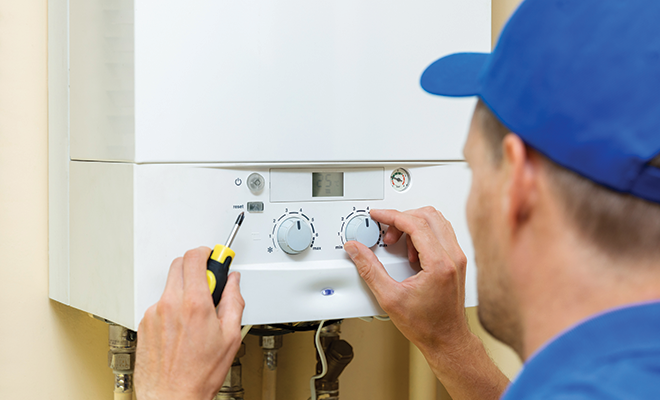
Tankless Water Heaters: Hot Water on Demand
The technology for heating water in the home hasn’t changed much since the last century. Most homes and apartments have a water heater that consists of a 40- to 50-gallon storage
tank and a gas, electric or propane heater that keeps water warm around the clock.
When a heater’s storage tank isn’t large enough for a household, it’s common to temporarily run out of hot water. Another down side of a traditional water heater is the risk of leaks that damage a home and its furnishings.
Long popular in Europe and Asia, tankless water heaters are becoming more common in the U.S. due to the benefits they provide. A tankless heater produces as much hot water as needed by heating cold water “on demand” with a gas burner or electrical coils, eliminating the need for a storage tank. Water is heated to the specified temperature in a fraction of a second when it passes through a pipe within the heater. Since warm water doesn’t sit around waiting to be used, energy loss isn’t a problem as it with storage tank heaters.
Tankless water heaters are typically rectangular and flat. They’re compact enough to be installed on an internal or external wall or in a closet. Besides saving space and avoiding the dangers of a leaky tanks, tankless heaters are more energy efficient, resulting in energy savings of 27 percent to 50 percent. According to Consumer Reports, heating water is the second-highest utility cost after heating and air conditioning for the average U.S. household. Saving energy is the main appeal of tankless heaters for many homeowners.
A single tankless heater can provide all the hot water used by a household, including faucets, showers, bathtubs and appliances. A unit large enough for an entire house averages about two feet high by one foot wide. This is referred to as a whole-home tankless water heater. Besides whole-home heaters, smaller tankless heater units can be installed at the point of use, or POU, such as a bathroom or laundry room. A POU tankless heater can also be used to heat water for a remote bathroom or electrically heated outdoor hot tub.
Besides being smaller and more energy efficient, tankless water heaters are cleaner and easier to maintain. Rust and mineral buildup is a problem with storage tank heaters, requiring regular flushing of the tank. Tankless heaters don’t have this problem and require very little ongoing maintenance, although they may be more expensive to repair when they break down.
Although a limitless supply of hot water is available with a tankless system, most heaters produce hot water at the rate of 2 to 5 gallons per minute. The flow rate of hot water may drop during times when demand exceeds this rate, such as when someone takes a shower while the dishwasher and washing machine are running. To overcome problems with the relatively low flow of hot water through a tankless heater during peak usage, the U.S. Department of Energy suggests installing two or more tankless water heaters connected in parallel or offloading demand on a home’s main tankless system with POU tankless heaters for appliances that use a lot of hot water.
The savings provided by a tankless water heater can only be realized after the cost of heater purchase and setup are covered, which may take several years. Consumer Reports data for 2019 shows that the initial purchase of a tankless heater system is typically more expensive than a traditional storage tank heater, about $525 to $1,150 for a tankless heater compared to $500 to $600 for the average 50-gallon storage tank heater. Following initial purchase, the lifespan of a tankless water heater is typically 20 years, twice as long as the average for units with storage tanks.
Making the switch from a storage tank heater to tankless may involve plumbing changes and an upgrade to a home’s electric or gas fuel capacity. Hiring a professional installer for a tankless system averages from $800 to $1,500, while a traditional storage tank heater costs $600 to $800 to install.
If you’re thinking about switching from a storage tank water heater to a tankless heater, you may want to calculate your energy savings and then compare the amount of time the heater will be under warranty compared to how long it will take to recover the cost of buying and installing it through energy savings. If the warranty will run out before the payback time, it may not make financial sense to make the switch. However, if you’re building a new home or renovating an old one and space is at a premium or you have a desire for endless hot water, then a tankless water heater may make perfect sense. ■
Sources: bobvila.com, lowes.com, energy.gov and consumerreports.org.







